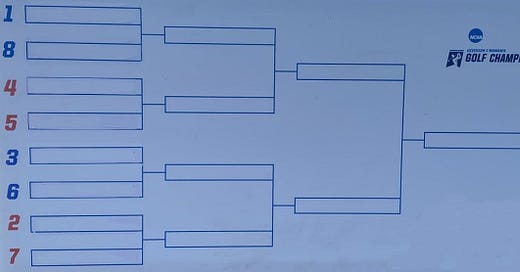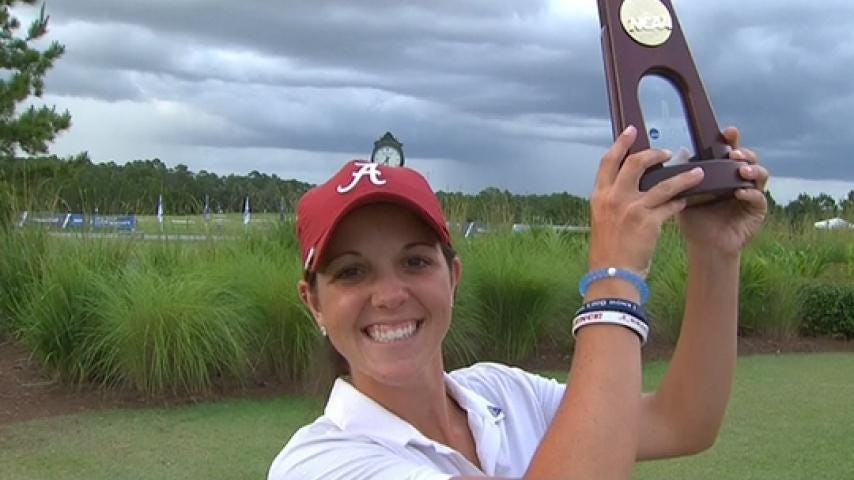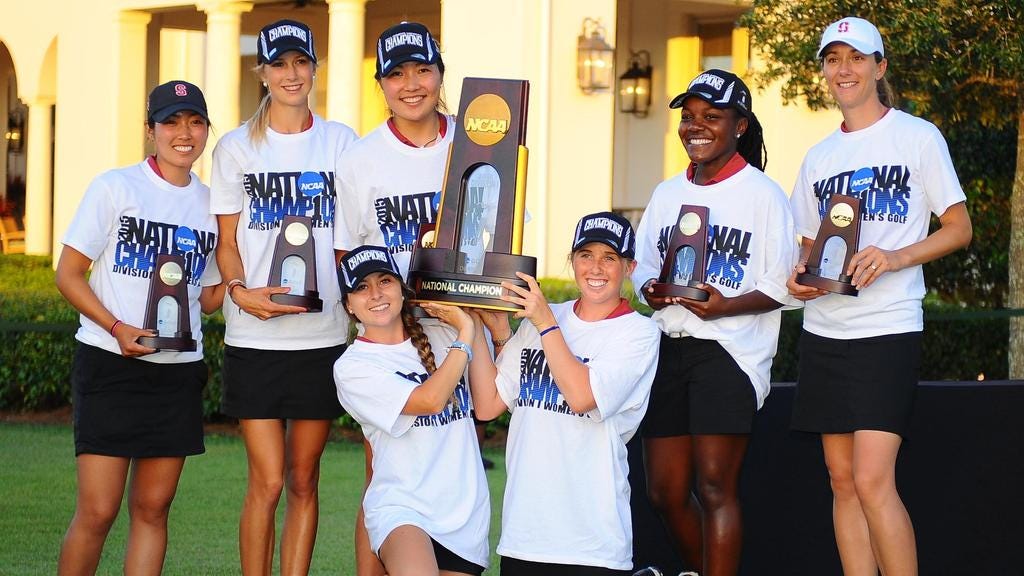This is part of a series on the Women’s Collegiate Championships
The 2015 D1 Women’s NCAA Golf Championship marked a new era in the sport. For the first time in its long history - much longer than the 33 championships held by the NCAA - four rounds of stroke play wasn’t enough to crown a championship team. Instead, the top 8 teams formed a match play bracket to decide the title, just as the men had done since 2009. For some it was heartbreak. For others, a new opportunity. It was difficult for everyone, and in the end it was as dramatic as many hoped, playing out on national television for the largest audience ever to witness women’s college golf history.
*NOTE: underlined text provides a link to references or sites with more information
THE END OF TEAM STROKE PLAY (ONLY)
Starting in 2009, match play was added (back) to the men’s NCAA championship to decide the team champion. After five years and a handful of refinements, the NCAA Championship Committee was happy enough with the format that they decided to use it to determine the women’s team champion starting in 2015. But first, there was one last championship decided purely by stroke play.
THE 2014 CHAMPIONSHIP
The Duke Blue Devils returned to Tulsa, OK - site of their first team title in 1999 - with high expectations. Another team with high aspirations were the defending champion Trojans from Southern California (USC). Duke had finished runner-up to USC the previous year at Georgia’s Golf Course, and now found themselves in a similar position as they made the turn in the final round. Undeterred, the Blue Devils went 6-under-par in the closing holes to secure a 2 stroke victory and their first title since 2007. USC’s Doris Chen shot a magnificent final round 67 to secure the individual title by 2 strokes over Duke’s Celine Boutier. It was a dramatic finish that nobody was quite sure next year’s match play format could replicate.
THE TOURNAMENT [May 22 - 27, 2015]
LIVE TV COVERAGE
For the first time since 1998, women’s college golf would play out its championship on national television. Golf Channel announced in early Spring that based on the success from airing the 2014 men’s tournament, the 2015 women’s NCAA championship would get the same treatment. In order to better facilitate the tv coverage, the 2015 tournament was also the beginning of the (ongoing) format that brought the women’s and men’s championships to the same site, separated by just a few days.
STROKE PLAY
The talk of the tournament even before it began was strokes. The kind taken with a golf club in hand, certainly, but also the kind of stroke players, coaches, and maybe even television viewers might have when seeing the scores posted. The famed Concession Golf Course was a championship caliber course that played up to those expectations, and the added weather made for a difficult couple of days. It took nearly a day and a half to get in the first 18 holes due to weather delays, yet it was the course setup that truly had emotions running hot. One player was asked why she was laughing at a difficult part in her round and her response was that otherwise she’d be crying. The emotional swings matched the scoring, and the running journal of events published by Golfweek’s Lance Ringler makes for a fascinating read as multiple delays caused chaos and re-re-planning. The 3rd round was finally completed on the morning of the fourth day, and with it came the cut to the top 15 teams and players in the hunt for the individual title. Mother Nature finally agreed to cooperate so that by the end of the day, all 72 holes had been completed, resulting in an individual champion and the 8 teams ready for match play.
INDIVIDUAL RESULTS
After reading the above, you might think that the winning score was probably well over par. In fact, the top four finishing players had final round scores in the 60s to give them total scores at or below par. Alabama’s Emma Talley shot a closing 69 to beat Arkansas’s Gaby Lopez (66!) and Duke’s Leona Maguire (68) by a single stroke. The 2013 US Women’s Amateur champ became just the fifth player to win both the Robert Cox trophy and the NCAA individual title. Talley won Alabama its first individual NCAA golf title, and became the second woman in school history to be crowned an individual college golf championship (Eleanor Dudley won the very first championship in 1941).
TEAM RESULTS
Since only the top 4 finishing individuals broke par, it was guaranteed that team scores were going to be high. The top 8 teams that would go on to the match play portion finished between 40 and 60 over par. Under the previous format, Southern California’s +40 score would have been the highest score for a winning team since 2003, which wouldn’t have mattered to them at all as they held the team championship trophy. Instead, they were awarded the top seed and the unsettling knowledge that in the six years that the men had been playing this format not a single #1 seed had won, most of them falling in the Quarterfinals. There was still a lot of golf to be played before anyone would be lifting that trophy.
Match Play
College golf team match play is fairly straightforward: 5 matches, pitting one player from each team in a head-to-head battle where each hole can be won or tied (regardless of the stroke total), and at the end each match is worth one point. The first team to 3 points wins the match and the team to win 3 matches goes home with the NCAA championship trophy.
For more than three decades, the season finale for women’s golf allowed one team to win and then a bunch of others to place. Nobody would ever call the teams that didn’t win losers. Now, the agony of defeat is real. Players can feel it and fans can see it. The win-or-go-home saying actually happens now. and quite frankly, it’s awesome.

The Quarterfinals ended the way it was expected to with the top four seeds each prevailing, but that doesn’t mean the matches were without drama. Both USC and Duke, playing like the two top championship-contending teams in the country, won their matches, but it wasn’t a walk in the park. Baylor, described as perhaps the hottest team in the country coming into the tournament - winning both the Big12 and Regional titles - continued their frenzied play. Likewise, Stanford seemed to finally be rounding back into top form after being knocked off their preseason mantle, defeating the Pac-12 champion Arizona team for the opportunity to meet another Pac-12 rival.
One of the biggest downsides to this new format is that the players are afforded only the time it takes to eat a quick lunch to celebrate their morning victory before they’re called back out to the battlefield course to fight again. The Semifinals could have each been championship matches, and the drama was ratcheted up another notch accordingly. Three of the USC/Stanford matches didn’t reach the 17th hole and one match ended up seeing two extra holes, but the one that ended on the 17th green proved to be the decider as USC realized the dreaded fate of the #1 seed. Likewise, in the Duke/Baylor match the lower seed prevailed, but not without creating some of the most intense drama yet seen at the NCAA championships. Baylor’s Lauren Whyte and Duke’s Lisa Maguire, who both finished near the bottom of the stroke play leaderboard, played some incredible golf down the stretch and ended up going 6 extra holes before the former prevailed and sent the Baylor Bears onto the Finals. The 24 holes it took to decide that match still stands as the record longest as of 2023.
The Finals match between Stanford and Baylor, two teams looking for their first ever championship, was everything that proponents of the new format could have hoped for. A couple matches ended on the 16th green, but that just helped bring more spectators to the longer-running matches. Through the conclusion of four matches, the score was knotted up at 2-2, coming down to the anchor match between Baylor’s English Am champ Hayley Davis and Stanford’s new superstar Mariah Stackhouse. Davis was already seasoned in match play, winning the 2014 English Women’s Open Am Stroke Play Championship, but Stackhouse had her own experience having just the year before competed in the Curtis Cup on the winning American side. Things looked close to being wrapped up when Davis hit an incredible shot out of the mud onto the 16th green - a shot that later made SportsCenter’s Top10 - which she converted into a birdie to go two up with two holes to play. Her back against the wall, Stackhouse made clutch birdies on 17 and 18 to square the match and send it to extra holes. The two women returned to the par-4 10th hole in front of a large crowd on the course and even larger one watching on tv. Four shots later and a missed putt by Davis, Stackhouse was mobbed by her Cardinal teammates, celebrating their national championship victory. The juxtaposition of the joy and heartbreak playing out on the 10th green for the tv cameras was not unique to sports, or even really college golf, but this time it seemed more...visceral. Just as it had for the men in 2009, the exciting result of this championship essentially cemented the new format going forward.
“It’s great,” Baylor coach Jay Goble said. “I was the first one to be hesitant about it originally, but going through the last two days, it’s really exciting, and really fun.”
“I just told the Golf Channel I thought we should keep it,” Walker added.
-2015 NCAA D1 Women’s Golf Record Book
EXTRA HOLES: USC TROJANS
The Southern California Trojans had a rich history of success even before entering the match play era. Their first runner-up finish at the NCAA championship came in 1994 and over the next 20 years they accumulated an impressive array of awards for their trophy case.
TEAM TITLES
Coach Andrea Gaston led the Trojans to the program’s first team championship in 2003 after leading the tournament from beginning to end. Five years later, the 2008 team again led wire-to-wire, capturing their second championship. Like clockwork, the third championship came five years after that in 2013. This time they not only led the entire time, they also shattered the NCAA championship record, finishing a full 19 strokes under par. The 2015 championship in which they again finished at the top of the leaderboard after four rounds of stroke play was as close as they had come to successfully defending one of their titles, and would have put them in (even more) rarified air having won four in just a little over a decade.
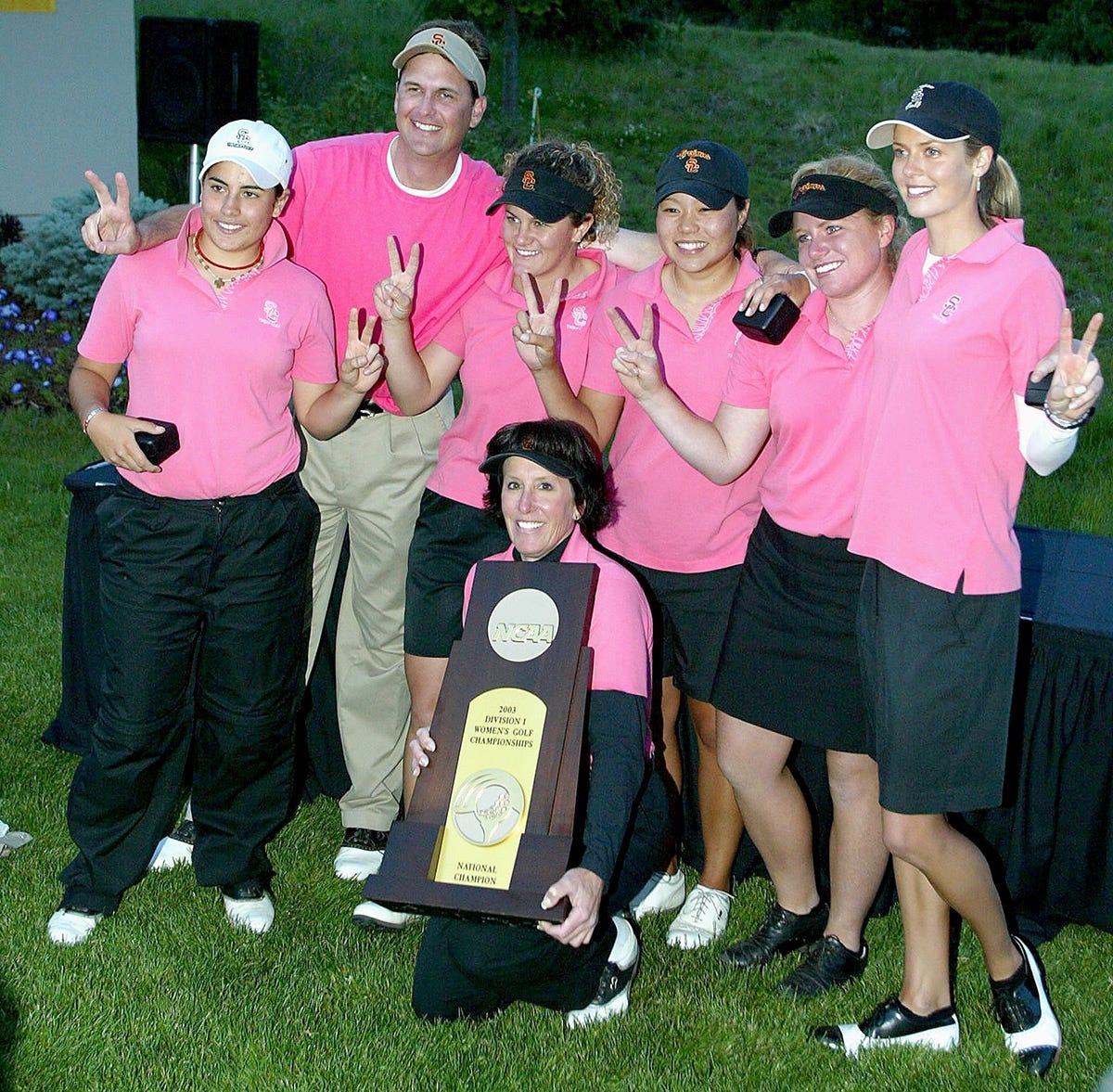

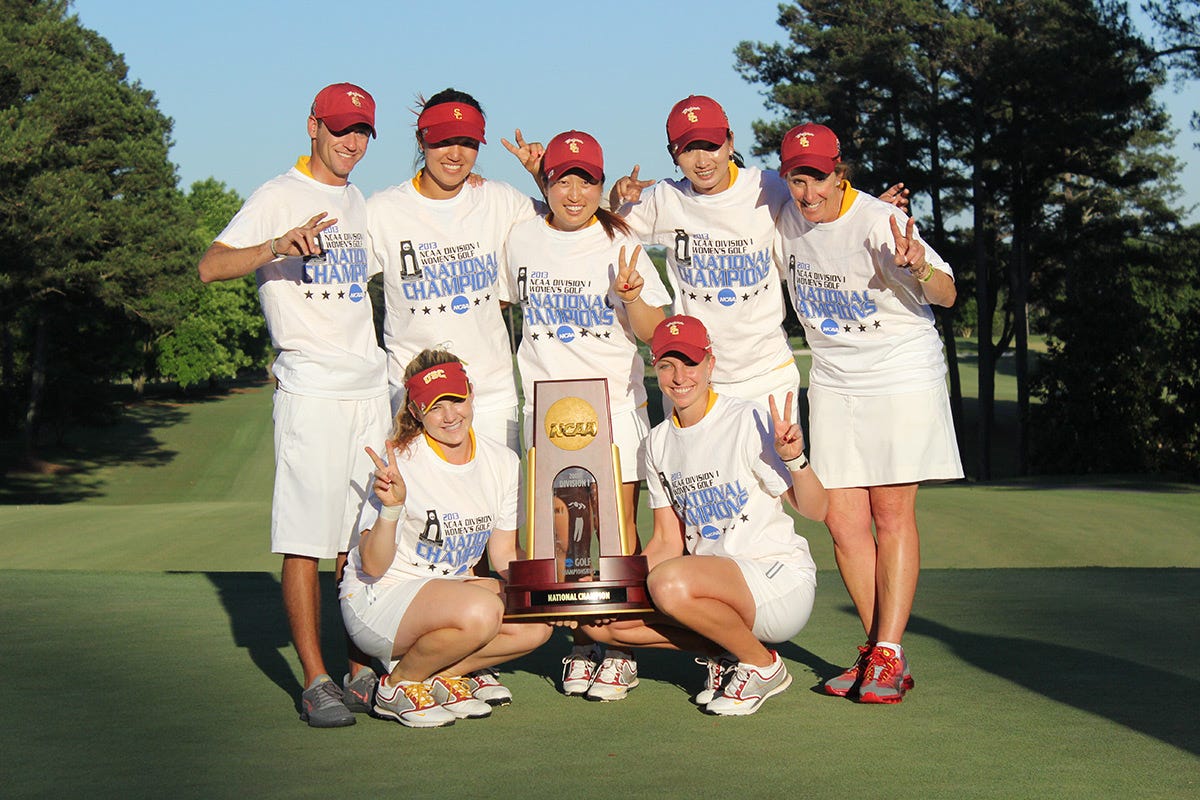
TEAM RUNNER-UP FINISHES
Winning is hard in golf which is why teams with multiple championships get all of the (deserved) attention. But finishing in the top 3 is also an incredible accomplishment that perhaps doesn’t get the respect it deserves. Proving just how consistently good they had been as a program, the Trojans have finished second four more times since 1994: 2006, 2010, 2012, and 2014. Incredibly, their three most recent runner-up finishes were decided by a grand total of four strokes: finishing behind Purdue by one stroke in 2010, behind Alabama by one stroke in 2012, and - as mentioned to start the post - behind Duke by only two strokes in 2014.
INDIVIDUAL TITLES
While the each of the teams as a whole were great, the individuals often found success at a high rate. Trojans have won five NCAA individual titles, including Jennifer Rosales in 1998, Mikaela Parmlid in 2003 (decided by a one-hole playoff), Dewi Claire Schreefel in 2006, Annie Park in 2013, and Doris Chen in 2014. Their back-to-back individual titlists was a first since Duke in 2001 and 2002, and USC is just the second team along with Arizona State to boast five total individual champions.
AWARDS AND HONORS
As you might expect, the honors came in as frequent as the wins over that time. Trojans earned multiple player awards such as Jennifer Rosales (1999) and Annie Park (2013) gaining the Women’s Golf Coaches Association (WGCA) Player of the Year Award. Lizette Salas joined Park in being named to the Pac-12 Women’s Golf All-Century team. Coach Andrea Gaston received her first national Coach of the Year award in 2008 which paired nicely with West Regional and Pac-10 Coach of the Year honors. Coach Gaston was inducted into the WGCA Hall of Fame in 2010, and then proceeded to win two more Coach of the Year awards in 2011 and 2013. By any measure the Trojans had fought well, and they continue to Fight On!
Thanks for reading!
Up Next:
In the final post of this series, we will cover Stanford’s three year run at Grayhawk from 2021-2023.

